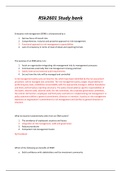RSk2601 Study bank
Enterprise risk management (ERM) is characterised by a
1. Narrow focus of hazard risks
2. Comprehensive, inclusive and proactive approach to risk management
3. Functional approach to risk management responsibilities
4. Lack of consistency in terms of level of detail and reporting formats
The purpose of an ERM policy is to
1. Assist an organisation integrating risk management into its management processes
2. Communicate externally that risk management is being practiced
3. Satisfy internal and external audit requirements
4. Set out how the risks will be managed and controlled
A risk management policy sets out how the risk, which have been identified by the risk assessment
procedure, will be managed and controlled. The risk management policy assigns responsibility for
performing key tasks, establishes accountability with the appropriate managers, defines boundaries
and limits and formalises reporting structures. The policy should address specific responsibilities of
the board, internal audit, external audit, the risk committee, the corporate governance committee,
the central risk function, employees and third party contractors in implementing risk management. A
policy statement defines a general commitment, direction or intention. A policy on risk management
expresses an organisation’s commitment to risk management and clarifies its general direction or
intention.
What do boards fundamentally seeks from an ERM system?
1. The avoidance of unpleasant surprises and losses
2. Integration of risk management, audit and governance
3. Robust procedures
4. Competent risk management teams
Pg 9 textbook
Which of the following are benefits of ERM?
a. Build confidence with stakeholders and the investment community
, b. Align risk appetite and strategy
c. Link risk with audit requirements
d. Seize opportunities
Choose the correct combination:
1. A, c
2. B, c
3. A, b, d
4. All of the above
The benefits of ERM include the following:
♦ Increase in the likelihood of a business realising its objectives
♦ Build confidence in stakeholders and the investment community
♦ Comply with relevant legal and regulatory requirements
♦ Align risk appetite and strategy
♦ Improve organisational resilience
♦ Enhance corporate governance
♦ Embed the risk process through the organisation
♦ Minimise operational surprises and losses
♦ Optimise allocation of resources
♦ Identify and manage cross enterprise risks
♦ Link growth, risk and return
♦ Rationalise capital
♦ Seize opportunities
♦ Improve organisational learning
Which of the following is typical to the traditional approach to risk management?
1. Risk management carried out in silos and extensive use of insurance
2. A comprehensive approach to managing risks
3. Integrating efforts of operations and risk managers
4. Viewing risk management as part of everyone’s daily routine
Traditionally, risk management has been segmented and carried out in “silos”. However, with the
dynamic environment and the evolving nature of risk, businesses encounter new types of risk while
pursuing new business objectives. There is therefore a need for an integrated framework for a
holistic approach to risk management.
,King III applies to
a. Banks
b. Insurance institutions
c. Public sector agencies
d. All listed companies on the JSE
Choose the correct combination:
1. A, b
2. A, b, d
3. A, b, c
4. All of the above
King III applies to all listed companies on the JSE, banks, financial and insurance institutions and
some public sector agencies.
The King III Report on Corporate Governance introduced which of the following new concepts?
a. Shareholder approval of remuneration policies
b. Alternative dispute resolution (ADR)
c. Directors’ performance evaluation
d. Business rescue
Choose the correct combination:
1. A, c
2. A, b, c
3. B, c, d
4. All of the above
The risk management policy forms part of the ERM
1. Scenario
2. Taxonomy
3. Framework
4. Structure
ERM is composed of seven elements namely: corporate governance, internal control,
implementation, risk management framework, risk management policy, risk management process
and sources of risk.
, Which one of the following is a recognised context stage (first stage) tool to obtain information on
the business?
1. GAP analysis
2. Database analysis
3. Investment analysis
4. PEST analysis
Mechanisms
- Finance analysis tools
- Risk management process diagnostic
- SWOT analysis
- PEST analysis
Gap analysis can be used to draw out the main risks to an activity or project and is commonly carried
out by calling upon department heads to complete a questionnaire.
During the context stage of a risk study, the ERM team for House and Home elects to examine House
and Home’s financial ratios to understand the business’ financial health before moving onto the risk
identification stage. This will enable them to
1. Provide a quick and relatively simple way to examine the financial position and performance
of House and Home
2. Assess whether House and Home’s records are regularly updated
3. Open the dialogue with the finance department and the internal auditors in House and
Home
4. Satisfy recommended ERM practices for this stage of the risk process in House and Home
Financial ratios: Financial analysis tools that are used to examine various aspects of financial position
and performance and that are widely used for planning, control and evaluation purposes.
A risk checklist is a useful tool for a business to determine
1. Its strengths and weaknesses in the micro environment
2. The internal environmental factors which may influence its performance
3. The main risks linked to a certain project of the business
4. The external environmental factors which may influence its performance
A risk checklist, as described by the PRAM Guide (Simon et al. 1997), is an in-house list of risks “that
were identified on previous projects”. Projects in the context of enterprise risk are either capital
investment projects or business activities. Risk checklists are often developed from managers’ past
experience. Checklists permit managers to capture lessons learnt and assess whether similar risks
are relevant to the business activities of today.




